Meta-Analysis of the Effect of Subsurface Irrigation on Crop Yield and Water Productivity
Abstract
:1. Introduction
2. Materials and Methods
2.1. Data Search and Collection
2.2. Meta-Analysis
2.3. Data Classification
2.4. Data Processing
3. Results
3.1. Comprehensive Effects of Subsurface Irrigation on Crop Yield, WP, IWP, and Tests of Publication Bias
3.2. Response of Crop Yield, WP, and IWP to Subsurface Irrigation as Influenced by Environmental Factors
3.3. Response of Crop Yield, WP, and IWP to Subsurface Irrigation as Influenced by Soil Factors
3.4. Response of Crop Yield, WP, and IWP to Subsurface Irrigation as Influenced by Field Management Factors
3.5. Response of Crop Yield, WP, and IWP to Subsurface Irrigation as Influenced by Irrigation Factors
3.6. Response of Crop Yield, WP, and IWP to Subsurface Irrigation as Influenced by Fertilization Factors
4. Discussion
4.1. Crop Yield, WP, and IWP Response to Subsurface Irrigation under Different Environmental Factors
4.2. Crop Yield, WP, and IWP Response to Subsurface Irrigation under Different Soil Factors
4.3. Crop Yield, WP, and IWP Response to Subsurface Irrigation under Different Field Management Factors
4.4. Crop Yield, WP, and IWP Response to Subsurface Irrigation under Different Irrigation Factors
4.5. Crop Yield, WP, and IWP Response to Subsurface Irrigation under Different Fertilization Factors
4.6. Advantages and Disadvantages of Subsurface Irrigation
5. Conclusions
Supplementary Materials
Author Contributions
Funding
Institutional Review Board Statement
Informed Consent Statement
Data Availability Statement
Conflicts of Interest
References
- Zohaib, M.; Kim, H.; Choi, M. Detecting global irrigated areas by using satellite and reanalysis products. Sci. Total Environ. 2019, 677, 679–691. [Google Scholar] [CrossRef] [PubMed]
- Wang, L.; Wu, W.; Xiao, J.; Huang, Q.; Hu, Y. Effects of different drip irrigation modes on water use efficiency of pear trees in northern China. Agric. Water Manag. 2021, 245, 106660. [Google Scholar] [CrossRef]
- Nagaraj, D.; Proust, E.; Todeschini, A.; Rulli, M.C.; D’Odorico, P. A new dataset of global irrigation areas from 2001 to 2015. Adv. Water Resour. 2021, 152, 103910. [Google Scholar] [CrossRef]
- Intrigliolo, D.S.; Ballester, C.; Castel, J.R. Carry-over effects of deficit irrigation applied over seven seasons in a developing Japanese plum orchard. Agric. Water Manag. 2013, 128, 13–18. [Google Scholar] [CrossRef]
- FAO AQUASTAT. Food and Agriculture Organization of the United Nations (FAO), Roma, Italy. 2018. Available online: http://www.fao.org/aquastat/en/ (accessed on 2 March 2021).
- Bai, H.; Tao, F.; Xiao, D.; Liu, F.; Zhang, H. Attribution of yield change for rice-wheat rotation system in China to climate change, cultivars and agronomic management in the past three decades. Clim. Chang. 2016, 135, 539–553. [Google Scholar] [CrossRef]
- Rahman, A.; Mojid, M.A.; Banu, S. Climate change impact assessment on three major crops in the north-central region of Bangladesh using DSSAT. Int. J. Agric. Biol. Eng. 2018, 11, 135–143. [Google Scholar] [CrossRef]
- Wada, Y.; de Graaf, I.E.M.; van Beek, L.P.H. High-resolution modeling of human and climate impacts on global water resources. J. Adv. Model. Earth Syst. 2016, 8, 735–763. [Google Scholar] [CrossRef]
- FAO AQUASTAT-Database. Food and Agriculture Organization of the United Nations (FAO), Roma, Italy. 2018. Available online: https://www.fao.org/aquastat/statistics/query/index.html;jsessionid=9D762F03F7A25EDCAAA00EBB7DD8383F (accessed on 20 March 2020).
- Abrahão, R.; García-Garizábal, I.; Merchán, D.; Causapé, J. Climate change and the water cycle in newly irrigated areas. Environ. Monit. Assess. 2015, 187, 22. [Google Scholar] [CrossRef]
- Allen, R.G.; Pereira, L.S.; Raes, D. FAO Irrigation and Drainage Paper No. 56; FAO: Roma, Italy, 1998. [Google Scholar]
- Zhang, L.; Wu, P.; Fan, X. Numerical simulation of soil water movement with drip irrigation of multiple point source. Trans. Chin. Soc. Agric. Eng. 2010, 26, 40–45. [Google Scholar] [CrossRef]
- Jin, Y.; Gao, X.; Zhang, R.; Wu, X.; Long, H.; Sun, Z.; Zhang, S. Comprehensive Assessment of Plant and Water Productivity Responses in Negative Pressure Irrigation Technology: A Meta-Analysis. Agronomy 2022, 12, 1925. [Google Scholar] [CrossRef]
- Gao, Y.; Yang, L.; Shen, X.; Li, X.; Sun, J.; Duan, A.; Wu, L. Winter wheat with subsurface drip irrigation (SDI): Crop coefficients, water-use estimates, and effects of SDI on grain yield and water use efficiency. Agric. Water Manag. 2014, 146, 1–10. [Google Scholar] [CrossRef]
- Zhang, Y.; Song, S.; Yang, H.; Xu, W.; Guo, P.; Yu, Y. Water-use efficiency of potted pakchoi in Yunnan laterite with root infiltration irrigation and anticlogging emitter. J. Irrig. Drain. Eng. 2019, 145, 04018038. [Google Scholar] [CrossRef]
- Zou, X.; Quan, T.; Zhou, M.; Yang, Q.; Shi, Y. Progress and prospects of moistube irrigation technology research. Bull. Soil Water Conserv. 2017, 37, 150–155. [Google Scholar] [CrossRef]
- Su, Y.; Guo, X.; Lei, T.; Zheng, L.; Ma, J.; Sun, X.; Hao, L.; Hu, F. Three-Dimensional Model of Soil Water and Heat Transfer in Orchard Root Zone under Water Storage Pit Irrigation. Water 2022, 14, 1813. [Google Scholar] [CrossRef]
- Chen, L.; Zhang, L.; Lu, Z.; Xian, F.; Zhang, J.; Cheng, Y.; Zhang, X.; Liu, Y. Effects of Trace Irrigation at Different Depths on Transcriptome Expression Pattern in Cotton (G. hirsutum L.) Leaves. BioMed Res. Int. 2020, 2020, 7248513. [Google Scholar] [CrossRef]
- Fan, Y.; Huang, N.; Gong, J.; Shao, X.; Zhang, J.; Zhao, T. A simplified infiltration model for predicting cumulative infiltration during vertical line source irrigation. Water 2018, 10, 89. [Google Scholar] [CrossRef]
- Kanda, E.K.; Niu, W.; Mabhaudhi, T.; Senzanje, A. Moistube irrigation technology: A review. Agric. Res. 2019, 9, 139–147. [Google Scholar] [CrossRef]
- Yao, J.; Qi, Y.; Li, H.; Shen, Y. Water saving potential and mechanisms of subsurface drip irrigation: A review. Chin. J. Eco-Agric. 2021, 29, 1076–1084. [Google Scholar] [CrossRef]
- Guo, F.; Ma, J.; Zheng, L.; Sun, X.; Guo, X.; Zhang, X. Estimating distribution of water uptake with depth of winter wheat by hydrogen and oxygen stable isotopes under different irrigation depths. J. Integr. Agric. 2016, 15, 891–906. [Google Scholar] [CrossRef]
- Guo, X.; Sun, X.; Ma, J.; Lei, T.; Zheng, L.; Wang, P. Simulation of the water dynamics and root water uptake of winter wheat in irrigation at different soil depths. Water 2018, 10, 1033. [Google Scholar] [CrossRef]
- Cai, Y.; Wu, P.; Zhu, D.; Zhang, L.; Zhao, X.; Gao, X.; Ge, M.; Song, X.; Wu, Y.; Dai, Z. Subsurface irrigation with ceramic emitters: An effective method to improve apple yield and irrigation water use efficiency in the semiarid Loess Plateau. Agric. Ecosyst. Environ. 2021, 313, 107404. [Google Scholar] [CrossRef]
- Thamer, T.; Nassif, N.; Almaeini, A.; Al-Ansari, N.; Hassan, D. Modeling of Different Irrigation Methods for Maize Using AquaCrop Model: Case Study. Engineering 2021, 13, 472–492. [Google Scholar] [CrossRef]
- Wang, J.; Gong, S.; Xu, D.; Yu, Y. Effects of irrigation models on the space distribution of root system andyield of winter wheat. J. Hydraul. Eng. 2011, 42, 1239–1246. [Google Scholar] [CrossRef]
- Umair, M.; Hussain, T.; Jiang, H.; Ahmad, A.; Yao, J.; Qi, Y.; Zhang, Y.; Min, L.; Shen, Y. Water-saving potential of subsurface drip irrigation for winter wheat. Sustainability 2019, 11, 2978. [Google Scholar] [CrossRef]
- Ardenti, F.; Abalos, D.; Capra, F.; Lommi, M.; Maris, S.C.; Perego, A.; Bertora, C.; Tabaglio, V.; Fiorini, A. Matching crop row and dripline distance in subsurface drip irrigation increases yield and mitigates N2O emissions. Field Crop Res. 2022, 289, 108732. [Google Scholar] [CrossRef]
- Mitchell-McCallister, D.; Cano, A.; West, C. Meta-analysis of crop water use efficiency by irrigation system in the Texas High Plains. Irrig. Sci. 2020, 38, 535–546. [Google Scholar] [CrossRef]
- Cheng, M.; Wang, H.; Fan, J.; Zhang, S.; Liao, Z.; Zhang, F.; Wang, Y. A global meta-analysis of yield and water use efficiency of crops, vegetables and fruits under full, deficit and alternate partial root-zone irrigation. Agric. Water Manag. 2021, 248, 106771. [Google Scholar] [CrossRef]
- Tong, X.; Wu, P.; Liu, X.; Zhang, L.; Zhou, W.; Wang, Z. A global meta-analysis of fruit tree yield and water use efficiency under deficit irrigation. Agric. Water Manag. 2022, 260, 107321. [Google Scholar] [CrossRef]
- Hedges, L.V.; Gurevitch, J.; Curtis, P.S. The meta-analysis of response ratios in experimental ecology. Ecology 1999, 80, 1150–1156. [Google Scholar] [CrossRef]
- Rosenberg, M.S.; Adams, D.C.; Gurevitch, J. MetaWin: Statistical Software for Meta-Analysis with Resampling Tests, 1st ed.; Sinauer Associates: Sunderland, MA, USA, 1997. [Google Scholar]
- Chen, H.; Li, X.; Hu, F.; Shi, W. Soil nitrous oxide emissions following crop residue addition: A meta-analysis. Glob. Chang. Biol. 2013, 19, 2956–2964. [Google Scholar] [CrossRef]
- Adams, D.C.; Gurevitch, J.; Rosenberg, M.S. Resampling tests for meta-analysis of ecological data. Ecology 1997, 78, 1277–1283. [Google Scholar] [CrossRef]
- Gurevitch, J.; Hedges, L.V. Statistical issues in ecological meta-analyses. Ecology 1999, 80, 1142–1149. [Google Scholar] [CrossRef]
- Morgan, P.B.; Ainsworth, E.A.; Long, S.P. How does elevated ozone impact soybean? A meta-analysis of photosynthesis, growth and yield. Plant Cell Environ. 2003, 26, 1317–1328. [Google Scholar] [CrossRef]
- Valkama, E.; Koricheva, J.; Oksanen, E. Effects of elevated O3, alone and in combination with elevated CO2, on tree leaf chemistry and insect herbivore performance: A meta-analysis. Glob. Chang. Biol. 2007, 13, 184–201. [Google Scholar] [CrossRef]
- Ainsworth, E.A. Rice production in a changing climate: A meta-analysis of responses to elevated carbon dioxide and elevated ozone concentration. Glob. Chang. Biol. 2008, 14, 1642–1650. [Google Scholar] [CrossRef]
- LeBauer, D.S.; Treseder, K.K. Nitrogen limitation of net primary productivity in terrestrial ecosystems is globally distributed. Ecology 2008, 89, 371–379. [Google Scholar] [CrossRef]
- Rosenthal, R. The file drawer problem and tolerance for null results. Psychol. Bull. 1979, 86, 638. [Google Scholar] [CrossRef]
- Rosenberg, M.S.; Adams, D.C.; Gurevitch, J. MetaWin (Version2.1). 2000. Available online: http://www.metawinsoft.com/ (accessed on 21 May 2022).
- Li, Q.; Chen, Y.; Sun, S.; Zhu, M.; Xue, J.; Gao, Z.; Zhao, J.; Tang, Y. Research on Crop Irrigation Schedules Under Deficit Irrigation—A Meta-analysis. Water Resour. Manag. 2022, 36, 4799–4817. [Google Scholar] [CrossRef]
- Yang, Z.; Hu, Y.; Zhang, S.; Raza, S.; Wei, X.; Zhao, X. The Thresholds and Management of Irrigation and Fertilization Earning Yields and Water Use Efficiency in Maize, Wheat, and Rice in China: A Meta-Analysis (1990–2020). Agronomy 2022, 12, 709. [Google Scholar] [CrossRef]
- Soil Survey Staff. Key to Soil Taxonomy, 12th ed.; USDA-Natural Resources Conservation Service: Washington, DC, USA, 2014; p. 360. [Google Scholar]
- Ginbo, T. Heterogeneous impacts of climate change on crop yields across altitudes in Ethiopia. Clim. Chang. 2022, 170, 12. [Google Scholar] [CrossRef]
- Chuma, B.A.; Cotter, M.; Kalisa, A.; Rajaona, A.; Senthilkumar, K.; Stuerz, S.; Vincent, I.; Asch, F. Altitude, temperature, and N Management effects on yield and yield components of contrasting lowland rice cultivars. J. Agron. Crop Sci. 2020, 206, 456–465. [Google Scholar] [CrossRef]
- Xiao, G.; Zhang, Q.; Li, Y.; Wang, R.; Yao, Y.; Zhao, H.; Bai, H. Impact of temperature increase on the yield of winter wheat at low and high altitudes in semiarid northwestern China. Agric. Water Manag. 2010, 97, 1360–1364. [Google Scholar] [CrossRef]
- Zhou, C.; Ge, X.; Huang, W.; Li, D.; Liu, Z. Effects of Aqua-Dispersing Nano-Binder on Clay Conductivity at Different Temperatures. Sustainability 2019, 11, 4859. [Google Scholar] [CrossRef]
- Sabziparvar, A.; Khoshhal Jahromi, F. Evaluating the most effective climatic parameters affecting the monthly mean soil temperature estimates using the PLS method. Arab. J. Geosci. 2022, 15, 1044. [Google Scholar] [CrossRef]
- Yu, L.; Zhao, X.; Gao, X.; Siddique, K.H. Improving/maintaining water-use efficiency and yield of wheat by deficit irrigation: A global meta-analysis. Agric. Water Manag. 2020, 228, 105906. [Google Scholar] [CrossRef]
- Faria, J.M.S.; Conceição, T.A.; Teixeira, D.M.; Brito, I.; Barrulas, P.; Pinto, A.P.; Vaz, M.; Carvalho, M. Arbuscular Mycorrhiza Extraradical Mycelium Promotes Si and Mn Subcellular Redistribution in Wheat Grown under Mn Toxicity. Int. J. Plant Biol. 2022, 13, 82–94. [Google Scholar] [CrossRef]
- Huang, L.; Liu, X.; Wang, Z.; Liang, Z.; Wang, M.; Liu, M.; Suarez, D.L. Interactive effects of pH, EC and nitrogen on yields and nutrient absorption of rice (Oryza sativa L.). Agric. Water Manag. 2017, 194, 48–57. [Google Scholar] [CrossRef]
- Wang, H.; Wang, N.; Quan, H.; Zhang, F.; Fan, J.; Feng, H.; Cheng, M.; Liao, Z.; Wang, X.; Xiang, Y. Yield and water productivity of crops, vegetables and fruits under subsurface drip irrigation: A global meta-analysis. Agric. Water Manag. 2022, 269, 107645. [Google Scholar] [CrossRef]
- Abdo, I.A.; Xu, Y.; Shi, D.; Li, J.; Li, H.; El-Sappah, A.H.; Elrys, S.A.; Alharbi, A.S.; Zhou, C.; Wang, L.; et al. Nitrogen transformation genes and ammonia emission from soil under biochar and urease inhibitor application. Soil Tillage Res. 2022, 223, 105491. [Google Scholar] [CrossRef]
- Wang, X.; He, J.; Bai, M.; Liu, L.; Gao, S.; Chen, K.; Zhuang, H. The Impact of Traffic-Induced Compaction on Soil Bulk Density, Soil Stress Distribution and Key Growth Indicators of Maize in North China Plain. Agriculture 2022, 12, 1220. [Google Scholar] [CrossRef]
- Asghari, S.; Abbasi, F.; Neyshabouri, M.R. Effects of soil conditioners on physical quality and bromide transport properties in a sandy loam soil. Biosyst. Eng. 2011, 109, 90–97. [Google Scholar] [CrossRef]
- Liu, J. Effects of Density and Row Spacing Configuration on Growth Development and Yield Quality of Cotton. Master’s Thesis, Tarim University, Alar, China, 2022. [Google Scholar] [CrossRef]
- Hu, L.; Pan, X.; Wang, X.; Hu, Q.; Wang, X.; Zhang, H.; Xue, Q.; Song, M. Cotton photosynthetic productivity enhancement through uniform row-spacing with optimal plant density in Xinjiang, China. Crop Sci. 2021, 61, 2745–2758. [Google Scholar] [CrossRef] [PubMed]
- Wan, W.; Li, L.; Jing, J.; Diao, M.; Lv, Z.; Li, W.; Wang, J.; Li, Z.; Wang, X.; Jiang, D. Narrowing row space improves productivity and profit of enlarged lateral space drip irrigated spring wheat system in Xinjiang, China. Field Crop. Res. 2022, 280, 108474. [Google Scholar] [CrossRef]
- Wan, W.; Zhao, Y.; Wang, Z.; Li, L.; Jing, J.; Lv, Z.; Diao, M.; Li, W.; Jiang, G.; Wang, X.; et al. Mitigation fluctuations of inter-row water use efficiency of spring wheat via narrowing row space in enlarged lateral space drip irrigation systems. Agric. Water Manag. 2022, 274, 107958. [Google Scholar] [CrossRef]
- Afzal, M.S.; Cheema, M.J.M.; Shahid, M.A.; Arshad, M.; Khaliq, T. Optimization of subsurface drip lateral depths and irrigation levels for best yield response of onion (Allium cepa L. ). J. Anim. Plant Sci. 2020, 30, 702–712. [Google Scholar] [CrossRef]
- Arbat, G.; Cufí, S.; Duran-Ros, M.; Pinsach, J.; Puig-Bargués, J.; Pujol, J.; Ramírez de Cartagena, F. Modeling Approaches for Determining Dripline Depth and Irrigation Frequency of Subsurface Drip Irrigated Rice on Different Soil Textures. Water 2020, 12, 1724. [Google Scholar] [CrossRef]
- Bhattarai, S.P.; Midmore, D.J.; Pendergast, L. Yield, water-use efficiencies and root distribution of soybean, chickpea and pumpkin under different subsurface drip irrigation depths and oxygation treatments in vertisols. Irrig. Sci. 2008, 26, 439–450. [Google Scholar] [CrossRef]
- Patel, N.; Rajput, T.B.S. Effect of drip tape placement depth and irrigation level on yield of potato. Agric. Water Manag. 2007, 88, 209–223. [Google Scholar] [CrossRef]
- Mo, Y.; Li, G.; Wang, D. A sowing method for subsurface drip irrigation that increases the emergence rate, yield, and water use efficiency in spring corn. Agric. Water Manag. 2017, 179, 288–295. [Google Scholar] [CrossRef]
- Duan, J.; Wang, G.; Wang, J.; Hao, X.; Luo, H.; Yang, G. Appropriate subsurface drip irrigation depth can improve the photosynthetic capacity and increase the economic coefficient of cotton without plastic mulching. Appl. Ecol. Environ. Res. 2022, 20, 3763–3777. [Google Scholar] [CrossRef]
- He, H.; Kang, S.; Cao, H. Effect of Lateral Depth on Root and Seedling Growth and Water Use Efficiency of Winter Wheat. Trans. Chin. Soc. Agric. Eng. 2001, 17, 31–33. [Google Scholar] [CrossRef]
- Yan, F.; Zhang, F.; Fan, X.; Fan, J.; Wang, Y.; Zou, H.; Wang, H.; Li, G. Determining irrigation amount and fertilization rate to simultaneously optimize grain yield, grain nitrogen accumulation and economic benefit of drip-fertigated spring maize in northwest China. Agric. Water Manag. 2021, 243, 106440. [Google Scholar] [CrossRef]
- Gebremariam, H.L.; Welde, K.; Kahsay, K.D. Optimizing yield and water use efficiency of furrow-irrigated potato under different depth of irrigation water levels. Sustain. Water Resour. Manag. 2018, 4, 1043–1049. [Google Scholar] [CrossRef]
- Yang, M.; Leghari, S.; Guan, X.; Ma, S.; Ding, C.; Mei, F.; Wei, L.; Wang, T. Deficit subsurface drip irrigation improves water use efficiency and stabilizes yield by enhancing subsoil water extraction in winter wheat. Front. Plant Sci. 2020, 11, 508. [Google Scholar] [CrossRef]
- Ma, X.; Han, F.; Wu, J.; Ma, Y.; Jacoby, P.W. Optimizing crop water productivity and altering root distribution of Chardonnay grapevine (Vitis vinifera L.) in a silt loam soil through direct root-zone deficit irrigation. Agric. Water Manag. 2023, 277, 108072. [Google Scholar] [CrossRef]
- Aydinsakir, K.; Dinc, N.; Isik, M.; Yegin, A.B.; Ozbek, O.; Bayram, S.; Bastug, R. Determining the Effect of Deficit Irrigation Applications on Yield and Quality Parameters in Grapefruit and Economical Assessment. J. Irrig. Drain. Eng. 2022, 148, 04022018. [Google Scholar] [CrossRef]
- Cao, Y.; Cai, H.; Sun, S.; Gu, X.; Mu, Q.; Duan, W.; Zhao, Z. Effects of drip irrigation methods on yield and water productivity of maize in Northwest China. Agric. Water Manag. 2022, 259, 107227. [Google Scholar] [CrossRef]
- Al-Ghobari, H.M.; Dewidar, A.Z. Integrating deficit irrigation into surface and subsurface drip irrigation as a strategy to save water in arid regions. Agric. Water Manag. 2018, 209, 55–61. [Google Scholar] [CrossRef]
- Zou, H.; Huang, X.; Gong, S. Effects of water deficit on soil moisture and temperature regimes in subsurface drip irrigated summer corn field. Trans. Chin. Soc. Agric. Mach. 2012, 43, 72–77. [Google Scholar] [CrossRef]
- Deng, T.; Wang, J.-H.; Gao, Z.; Shen, S.; Liang, X.-G.; Zhao, X.; Chen, X.-M.; Wu, G.; Wang, X.; Zhou, S.-L. Late split-application with reduced nitrogen fertilizer increases yield by mediating source–sink relations during the grain filling stage in summer maize. Plants 2023, 12, 625. [Google Scholar] [CrossRef]
- Hamad, A.A.A.; Wei, Q.; Xu, J.; Hamoud, Y.A.; He, M.; Shaghaleh, H.; Wei, Q.; Li, X.; Qi, Z. Managing Fertigation Frequency and Level to Mitigate N2O and CO2 Emissions and NH3 Volatilization from Subsurface Drip-Fertigated Field in a Greenhouse. Agronomy 2022, 12, 1414. [Google Scholar] [CrossRef]
- Tanaskovik, V.; Cukaliev, O.; Kanwar, R.S.; Heng, L.K.; Markoski, M.; Spalevic, V. Nitrogen fertilizer use efficiency of pepper as affected by irrigation and fertilization regime. Not. Bot. Horti Agrobot. 2016, 44, 525–532. [Google Scholar] [CrossRef]
- Fu, P.; Ji, H.; He, Q.; Tang, S.; Wang, H.; Wu, Y.; Meng, L. Effects of Nitrogen Fertilizer Application Times and Nitrification Inhibitor on N2O Emission from Potted Maize. Chin. J. Environ. Sci. 2021, 42, 4538–4547. [Google Scholar] [CrossRef]
- Fu, B.; Li, Z.; Gao, X.; Wu, L.; Lan, J.; Peng, W. Effects of subsurface drip irrigation on alfalfa (Medicago sativa L.) growth and soil microbial community structures in arid and semi-arid areas of northern China. Appl. Soil Ecol. 2021, 159, 103859. [Google Scholar] [CrossRef]
- Kim, J.; Kim, P.; Kim, S.; Kim, J.; Eum, D.; Lee, S. Pressure drop analysis of subsurface irrigation dripper system and its flow rate uniformity. J. Mech. Sci. Technol. 2023, 37, 203–208. [Google Scholar] [CrossRef]
- Wang, J.; Niu, W.; Li, Y.; Lv, W. Subsurface drip irrigation enhances soil nitrogen and phosphorus metabolism in tomato root zones and promotes tomato growth. Appl. Soil Ecol. 2018, 124, 240–251. [Google Scholar] [CrossRef]
- Lamm, F.R.; Colaizzi, P.D.; Sorensen, R.B.; Bordovsky, J.P.; Dougherty, M.; Balkcom, K.; Zaccaria, D.; Bali, K.M.; Rudnick, D.R.; Peters, R.T. A 2020 vision of subsurface drip irrigation in the US. Trans. ASABE 2021, 64, 1319–1343. [Google Scholar] [CrossRef]
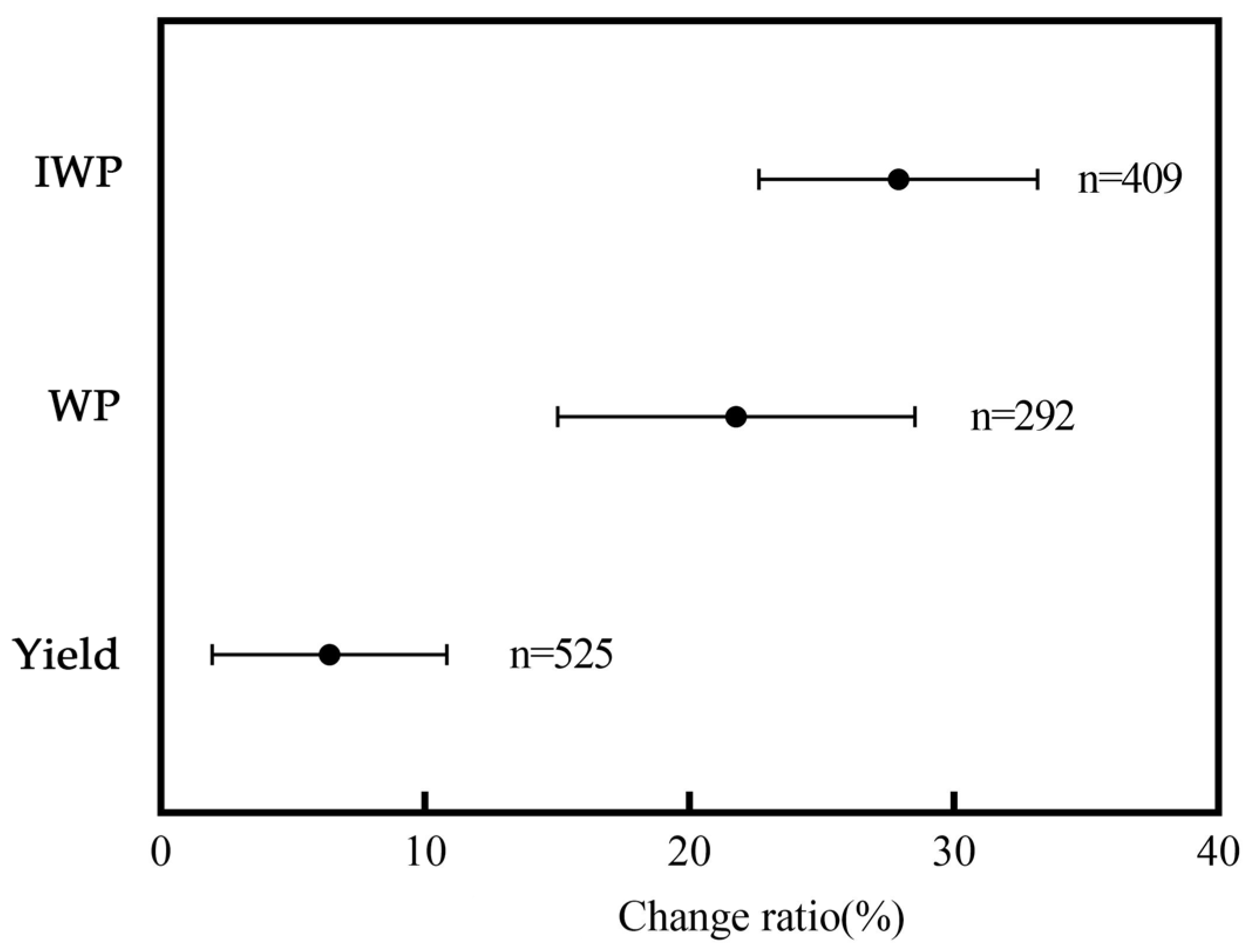
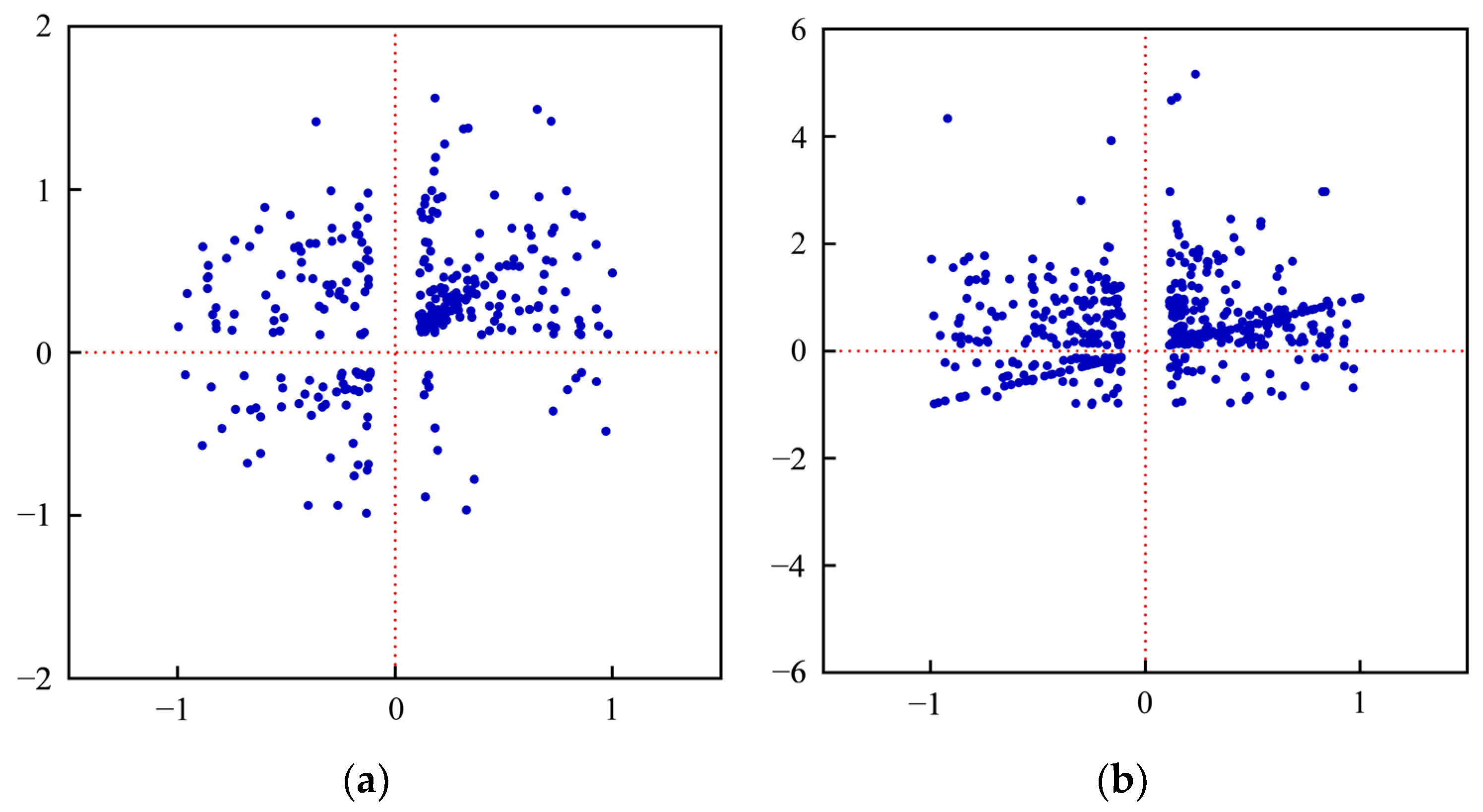
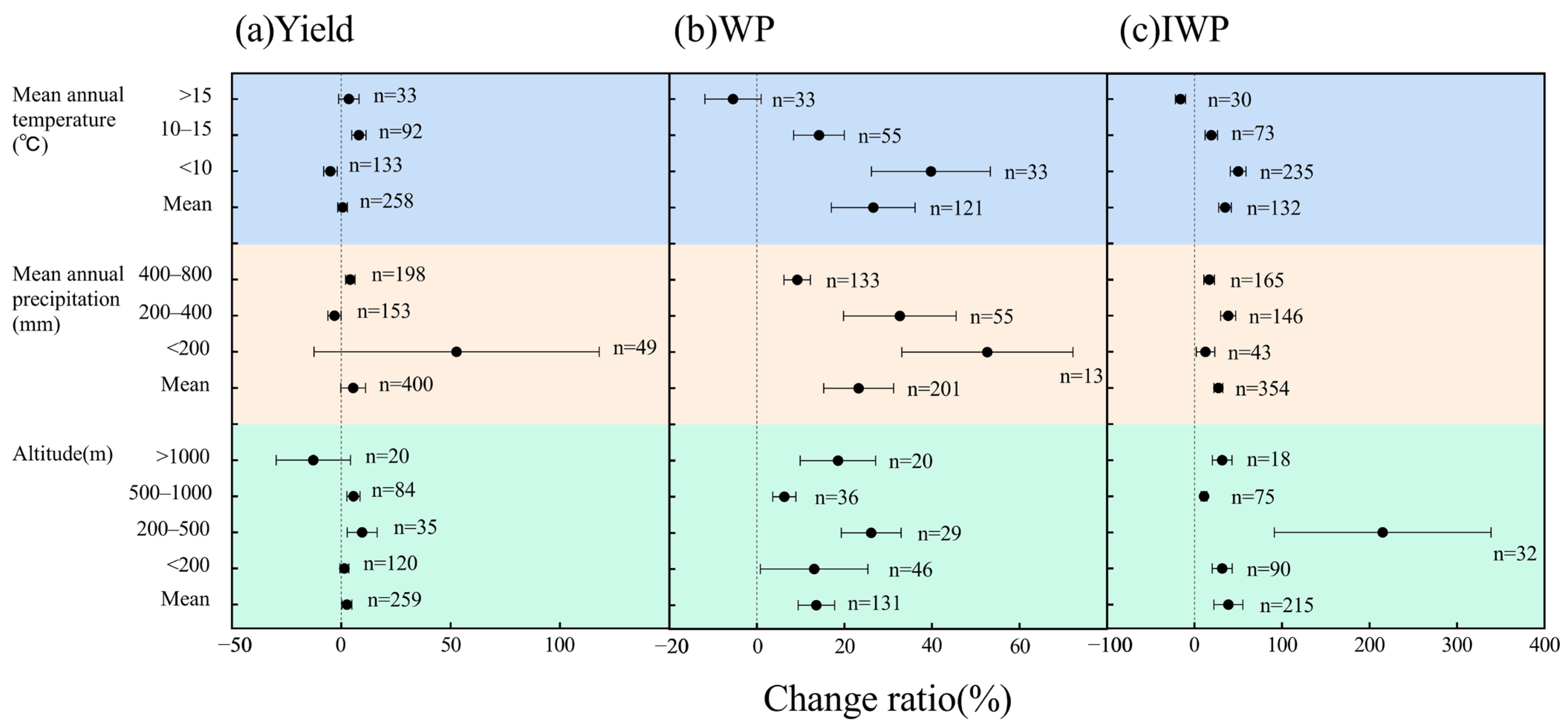

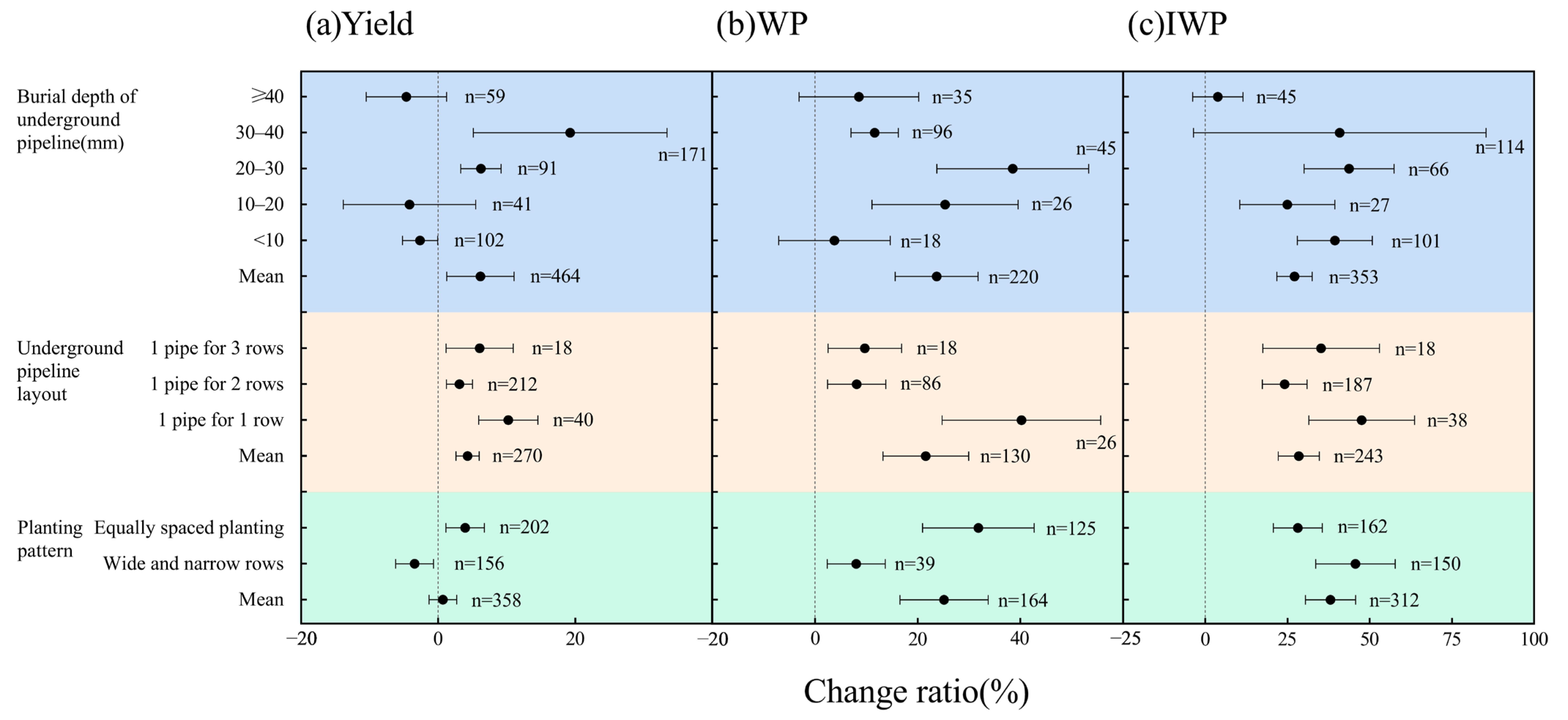
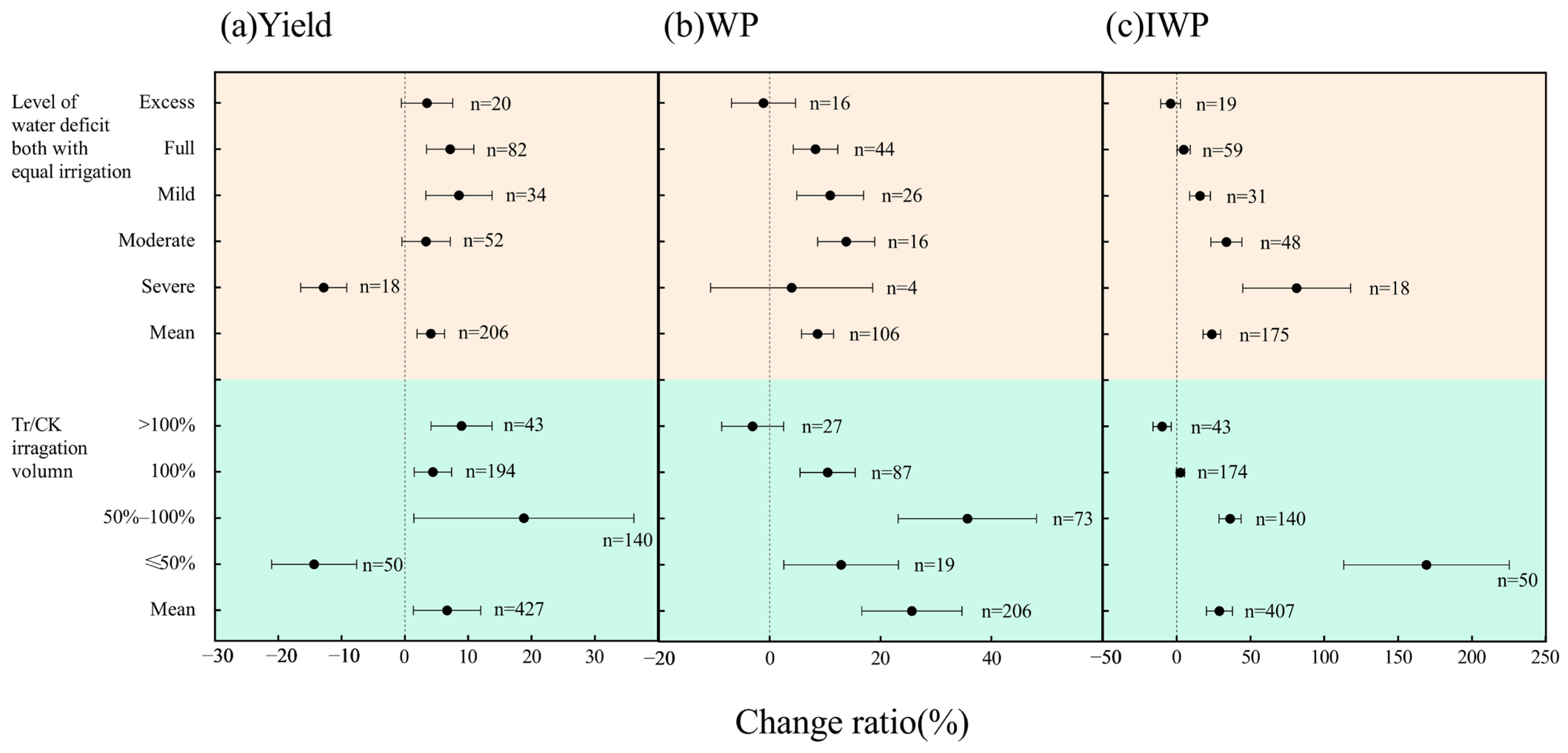
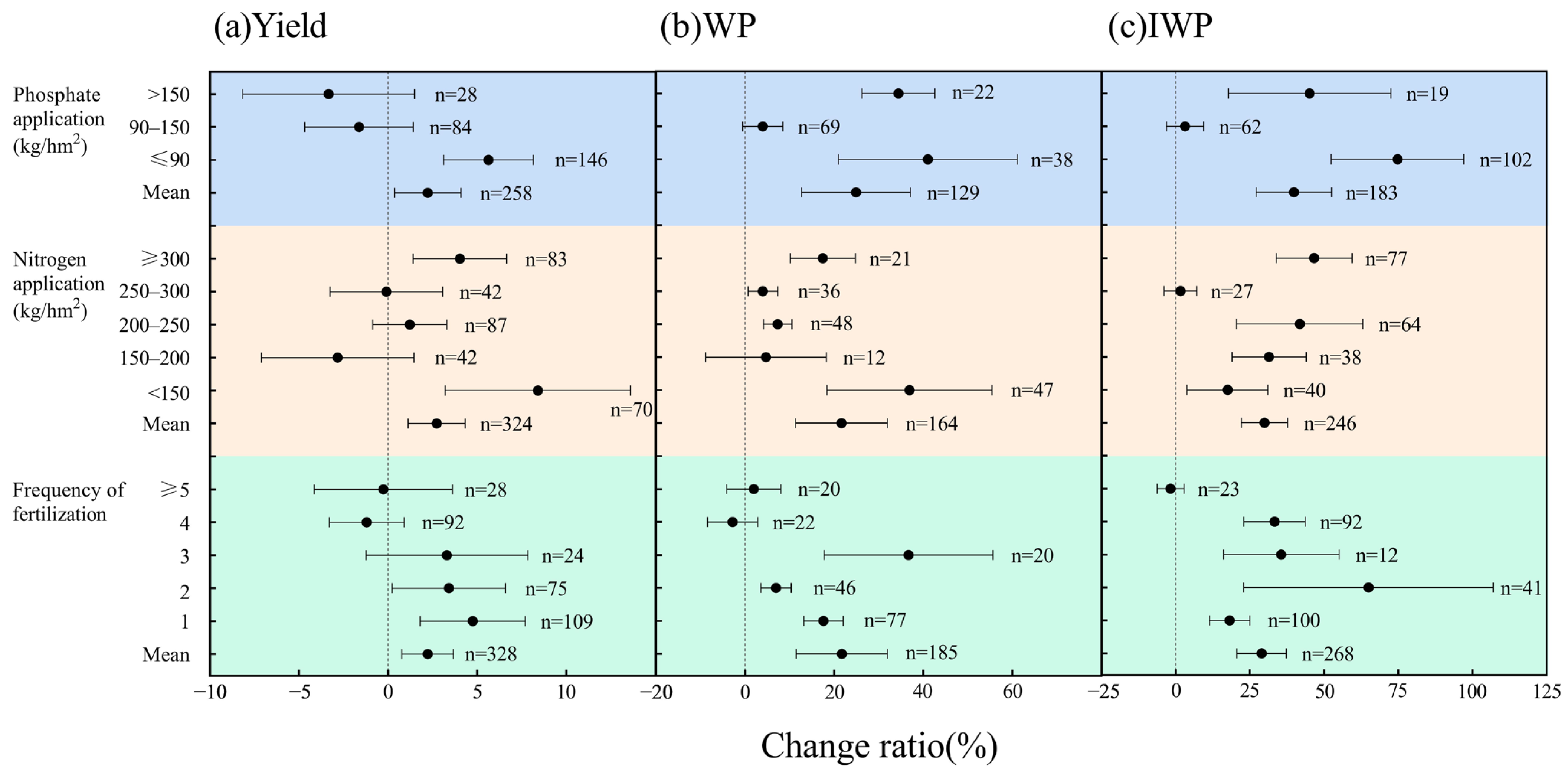
| Indicators | Number of Study Articles (n) | Fail-Safe N | 5n + 10 | Whether Bias Exists |
|---|---|---|---|---|
| Yield | 525 | 16,937 | 2635 | No |
| WP | 292 | 6897.9 | 1470 | No |
| IWP | 409 | 14,639.5 | 2055 | No |
| Factor Classification | Factors | Subgroups and Criteria |
|---|---|---|
| Environmental factors | Altitude (m) | <200, 200–500, 500–1000, >1000 |
| Mean annual Temperature (°C) | <10, 10–15, >15 | |
| Mean annual precipitation (mm) | <200 (arid zones), 200–400 (semi-arid zones), 400–800 (semi-humid zones) | |
| Soil factors | Soil texture [45] | Coarse soils (sandy loam, sandy clay loam, loamy sandy loam, sandy clay loam), medium soils (loamy loam, chalky loam, chalky loam), fine soils (clay, clay loam, chalky loam, chalky clay loam) |
| Soil pH | Acidic (pH < 6.5), alkaline (pH = 7.5–8.5), strongly alkaline (pH > 8.5) | |
| Soil bulk density (g/cm3) | ≤1.25, 1.25–1.35, 1.35–1.45, 1.45–1.55, >1.55 | |
| Field management factors | Planting pattern | Equally spaced planting, wide and narrow rows |
| Underground pipeline layout | 1 pipe for 1 row, 1 pipe for 2 rows, 1 pipe for 3 rows | |
| Burial depth of underground pipeline (cm) | <10, 10–20, 20–30, 30–40, ≥40 | |
| Irrigation factors | Tr/CK irrigation volume | ≤50%, 50–100%, 100%, >100% |
| Level of water deficit in both with equal irrigation | Severe (<40% FC 1/40% ETc 2), moderate (40–50% FC/40–60% ETc), mild (50–60% FC/60–80% ETc), full (60–80% FC/80–105% ETc), excess (≥90–100%FC/120%ETc) | |
| Fertilization factors | Frequency of fertilization | 1, 2, 3, 4, ≥5 |
| Nitrogen application (kg/ha) | <150, 150–200, 200–250, 250–300, ≥300 | |
| Phosphorus application (kg/ha) | ≤90, 90–150, >150 |
Disclaimer/Publisher’s Note: The statements, opinions and data contained in all publications are solely those of the individual author(s) and contributor(s) and not of MDPI and/or the editor(s). MDPI and/or the editor(s) disclaim responsibility for any injury to people or property resulting from any ideas, methods, instructions or products referred to in the content. |
© 2023 by the authors. Licensee MDPI, Basel, Switzerland. This article is an open access article distributed under the terms and conditions of the Creative Commons Attribution (CC BY) license (https://creativecommons.org/licenses/by/4.0/).
Share and Cite
Guo, J.; Zheng, L.; Ma, J.; Li, X.; Chen, R. Meta-Analysis of the Effect of Subsurface Irrigation on Crop Yield and Water Productivity. Sustainability 2023, 15, 15716. https://doi.org/10.3390/su152215716
Guo J, Zheng L, Ma J, Li X, Chen R. Meta-Analysis of the Effect of Subsurface Irrigation on Crop Yield and Water Productivity. Sustainability. 2023; 15(22):15716. https://doi.org/10.3390/su152215716
Chicago/Turabian StyleGuo, Jin, Lijian Zheng, Juanjuan Ma, Xufeng Li, and Ruixia Chen. 2023. "Meta-Analysis of the Effect of Subsurface Irrigation on Crop Yield and Water Productivity" Sustainability 15, no. 22: 15716. https://doi.org/10.3390/su152215716
APA StyleGuo, J., Zheng, L., Ma, J., Li, X., & Chen, R. (2023). Meta-Analysis of the Effect of Subsurface Irrigation on Crop Yield and Water Productivity. Sustainability, 15(22), 15716. https://doi.org/10.3390/su152215716






